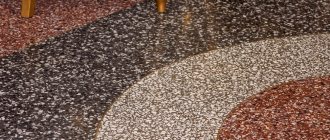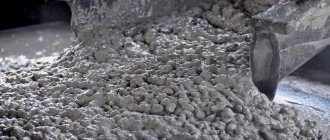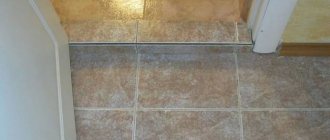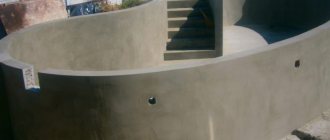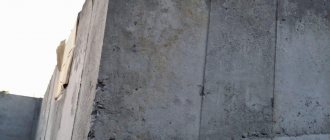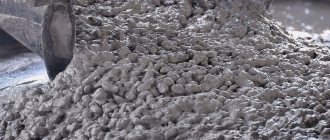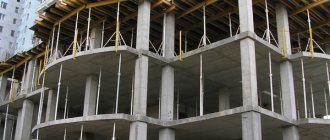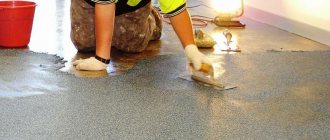Floor topping is widely used in modern construction. With its help, the concrete floor is strengthened even before it hardens.
The main purpose of floor topping is to give concrete floors and screeds additional strength, improve their performance characteristics, increase wear resistance, and extend the service life of concrete bases.
Concrete floors with topping have an attractive aesthetic appearance. If necessary, colored toppings can be used to create a decorative effect.
Corundum topping is one of the types of toppings. Toppings for concrete may have other fillers consisting of various minerals, metal ceramics, metal alloys, and abrasives of different hardness. As a result of the use of these additives, for example, metallized or quartz topping is obtained, which includes quartz sand.
Corundum toppings differ from all other types of topping in that they do not rust and can withstand significant loads. The scope of application of concrete floors with corundum topping is very wide and has practically no restrictions.
MANUFACTURERS
- HAGAst (Noginsk)
- HeatAvangard
- Perel (Shchelkovo)
- Hagastapel (Electrocoal)
- Quick Mix
- Terta
- Osnovit (Kolomna)
- Linolit
- Plifort
Each of these manufacturers, thanks to special formulations and their own technologies, have developed and produce construction, finishing, waterproofing, fireproofing materials with the best technical characteristics for a specific area of application in construction.
Properties of corundum topping
The main feature of corundum topping is the increased resistance of concrete floors treated with it to abrasion. Strong corundum chips included in the topping provide additional shine to the floor surface.
Corundum toppings have high strength and abrasion resistance. Concrete floors with corundum topping are resistant to mechanical shock. They can withstand heavy loads. Such floors are hygienic, dust-free, impervious to various types of substances, and easy to clean.
Composition and technical characteristics of corundum topping
A little about corundum as a natural material for making toppings. After diamond, it is the hardest gemstone, having a hardness of 9. Corundums are also called “eternal stones.” From a chemical point of view, corundum is ordinary aluminum oxide – Al2O3. In its pure form it is colorless, but due to impurities of chromium, iron and other chemical elements, corundum can acquire different shades and be painted in different colors. Only a minimal part of the mined corundum is used in jewelry. Their main area of application is industrial and technical needs.
The composition of corundum topping includes high-strength cement, corundum and various modifying additives. The topping mixture is packaged in bags. Its consumption per 1 m2 ranges from 3 to 5 kg and is determined by the performance characteristics of the floors. The adhesion of the hardener to the concrete base is 3 MPa.
ACII
Promotion
GROUT
- for stone
- for clinker
- for thermal panels
Always in stock 765 rub. / 25 kg
more details
Promotion
MASONRY MORTAR
- for brick
Always in stock 310 rub. / 50 kg
more details
Promotion
WARM MASONRY MORTAR
Always in stock 260 rub. / 25 kg
more details
Promotion
FACING BRICK
- red
- straw
- chocolate
Always in stock 9.50 rub. / PC
more details
Promotion
SOLUTION for laying domestic bricks
Always in stock 250 rub. / 25 kg
more details
Application of corundum topping
Corundum topping is used for constructing concrete floors in warehouses, garages, various workshops and other premises where there are increased requirements for abrasion resistance and dust formation is not allowed.
When installing industrial floors, corundum topping is applied to the concrete that has not yet hardened. The base should consist of low-shrinkage composite concrete. The surface is leveled and vibrated. The application of topping begins after the concrete has hardened to such a consistency that it can be stepped on its surface without leaving significant marks.
The hardener is spread manually or using mechanical devices and then leveled with smoothing slats. The corundum topping is rubbed using wing-type grinding devices. The first mashing is carried out with a disk, all subsequent mashes with “wings”.
After grouting and polishing the topping, the floors are filled with impregnation using a sprayer. When applying it, there should be no drafts in the room.
Disbon DisboTop Korund / Disbon Disbotop Korund corundum topping
Directions for use when installing a new floor
The dry mixture Disbotop Korund is distributed over the surface of freshly laid concrete and rubbed into the surface using special equipment, followed by application of the Aquastat E hardened surface care product.
Surface preparation
The temperature of the base and the environment during work is not lower than +5ºС. At temperatures above +25ºС and relative humidity less than 60%, as well as in the presence of wind, it is necessary to take into account that the concrete mixture in these conditions quickly loses water and the concrete hardening process accelerates. Foundation preparation, reinforcement, concrete grade, concrete slab thickness are selected and specified according to the design and in accordance with SNiP 2.03.13, SNiP 3.03.01, SNiP 3.04.01 and current regulatory documents.
Requirements for concrete mixture
The presence of additives that involve air in the concrete mixture, as well as additives based on salts that contribute to the formation of efflorescence, is not allowed. The concrete mixture should not contain any inclusions of clay; it is recommended that the fine aggregate fineness modulus be at least 2.0. The maximum size of coarse aggregate is selected depending on the thickness of the slab. Concrete grade – not lower than 300 (B22.5).
Receiving, laying, compacting and troweling concrete mixture
The concrete mixture is accepted and laid in accordance with SNiP 3.03.01 and current regulatory documents. In this case, it is necessary to ensure that gaps in the acceptance of concrete are minimal in order to avoid the appearance of cracks along the cold concreting seam. The concrete is placed so that the finished floor mark (0.000) is reached. To do this, you can use an internal vibrator or vibrating screed to compact concrete. Compaction with a vibrating screed is carried out along guides that are pre-aligned on the level. Once the concrete has been compacted, the guides can be left in the concrete or removed. It is recommended to level the concrete after removing the guides using the edge of a wooden board 2 - 3 cm thick and 2 - 3 meters long. Grouting can be done as soon as the concrete begins to support the weight of the trowel disc. Grouting should be done primarily along the edges and in places near the columns. Before grouting, remove excess water from the surface of the concrete, for example, using a rubber hose or trowel dragged over the surface of the concrete. Concrete adjacent to structures, columns, holes, doorways and walls should be treated first as it hardens faster in these areas.
First application of the strengthening mixture
Strengthen the technological (working) seams. Apply 70% of the calculated amount of dry mixture to the surface using a special dispenser or manually. Try to achieve a uniform layer thickness. Do not scatter or level the mixture with a shovel! First of all, apply the mixture to areas near walls, columns, and doorways of structures, since these areas are the first to lose moisture. In hard-to-reach places, you should not use a trolley when applying the dry mixture; in this case, the dry mixture is poured out of the bag directly onto the floor and then distributed over the surface using hand tools. After distributing the dry mixture, it is necessary to allow it to become saturated with water from the concrete base (determined by the darkening of the surface).
First grouting of the strengthening mixture
Start grouting using hand tools or a trowel with a disk, near walls, columns, doorways, etc. Grouting using a trowel must be done as soon as the mixture absorbs moisture from the concrete (this will be visible by the darkening of the surface of the dry mixture). When working with trowels, you need to try to step over as little as possible and try to process as large an area as possible while standing in one place. When carrying out grouting work, it is recommended to walk on the freshly grouted area as little as possible. Workers should try to move along the edges of the new floor and use wooden boards, upholstered underneath with any soft material (for example, foam rubber). Trowel operators should immediately eliminate traces caused by walking on a freshly grouted floor with an additional pass of the trowel.
Second application of the strengthening mixture
After completing the first grout, you should immediately apply the remaining part (30%) of the mixture so that it has time to soak in water. In this case, you should retreat 10 cm from the walls and edges of the map being filled in. If the area to which the dry mixture is applied is not saturated with water, additional moistening is allowed. Second grouting of the strengthening mixture After the mixture is saturated with moisture (which will be visible by darkening of the surface), immediately begin the second grouting with a machine with discs.
Additional grouting of the strengthening mixture
The surface can be additionally grouted using the third and fourth grouts, if after the first two the dry mixture has not yet been thoroughly rubbed into the concrete surface (if time and properties of the concrete mixture allow).
First smoothing of the strengthening mixture
When the concrete surface becomes harder and loses some of its shine, you can begin smoothing with a trowel with blades (“helicopters”). The blades should be installed with a minimum angle of inclination, but should not “burrow” into the concrete surface.
Second smoothing of the strengthening mixture
When the surface dries, it must be smoothed again. The angle of inclination of the blades at this stage can be slightly increased. Later, when the surface “pulls together”, it must be smoothed again; the blades of the trowel can be slightly raised at this stage. Note: in high temperatures or in windy conditions, smoothing should be carried out without delay. These conditions promote evaporation of moisture, and any delays in finishing may result in rejects.
Third and subsequent smoothings of the strengthening mixture
They are carried out depending on the required surface quality. Criterion - the surface must be smooth and have a mirror shine. With each subsequent smoothing, the angle of inclination of the blades should be increased, and the drier and harder the coating, the higher the speed of the trowel should be set.
Applying concrete care product
Immediately after finishing smoothing, apply Aquastat E concrete care product to the surface using a roller or spray. After the care product has dried, it is advisable to isolate the concrete surface from the environment. For example, cover with plastic wrap) for 5 - 7 days. This avoids contamination, discoloration or physical damage to the hardened surface.
Cutting and sealing seams
Cut temperature-shrinkage joints after the concrete has gained sufficient strength, approximately 24 to 36 hours after completion of work. To fill the joints, it is recommended to use Disbothan 240 PU-Dichtstoff sealant (before use, read the technical description of this material).
Cleaning instruments
Rinse work tools thoroughly with water before the cement material hardens on the trowel blades and tools.
Conditions of use
During the first 14 days, the temperature of the base and ambient air should be at least + 5 ºС. At temperatures above + 25 ºС (and) or relative humidity less than 60%, as well as in the presence of wind (drafts), it is necessary to prevent excessive loss of moisture from the concrete slab (by covering it, for example, with plastic film).
Drying time
On the second day, it is possible to walk on the surface (in shoes with soft soles), move vehicles on rubber wheels without a load after 14 days, and be ready to withstand design loads no earlier than after 28 days.
Popular brands of topping floors
| Photo | Name | Rating | Price | |
| #1 | Mapetop N AR6 | ⭐ 98 / 100 | More details | |
| #2 | MasterTop 450 | ⭐ 96 / 100 | More details | |
| #3 | Sikafloor 1 MetalTop | ⭐ 92 / 100 | More details |
Many manufacturers produce dry hardeners for concrete floors. There are several different types of options available.
Sikafloor 1 MetalTop
Composition : Cement, metal filler treated against corrosion, additives, pigments.
Consumption , kg, sq. m: About 5.
Compressive strength , MPa: From 70 (after 28 days).
Abrasion : AR 0.5.
Sikafloor 1 MetalTop
MasterTop 450
Composition : Corundum (particle size up to 1.4 mm), highly active Portland cement, additives.
Consumption , kg, sq. m: 4...8.
Compressive strength , MPa: From 55 (after 28 days).
Abrasion resistance : AR 1.
MasterTop 450
Mapetop N AR6
Composition : quartz filler (fraction up to 2.5 mm), Portland cement, additives.
Consumption , kg, sq. m: 3…5 with mechanized application.
Compressive strength , MPa: From 30 (every other day). From 65 (in 4 weeks).
Abrasion : Less than 0.5 g/sq. cm.
Mapetop N AR6
What is topping
Topping is a special concrete hardener, sold in the form of a dry mixture, which consists of cement, plasticizing additives, fixatives and dyes. The highest quality mixtures contain at least 6 additives (for example, microfiber, ceramics and other materials). Thanks to the topping, not only the strength but also the wear resistance of the floors increases. At the same time, dust will no longer form on them.
The technology for applying the hardener is reminiscent of the well-known ironing method, when a thin layer of dry cement is laid on freshly laid concrete and the surface is thoroughly rubbed. However, this method is now considered obsolete. In addition, as practice shows, ironing is not the most effective way to strengthen the base.
If we talk about toppings, they contain special additives that improve the structure of the top layer of the floor. At the same time, the fine-grained filler adds texture to the surfaces.
Improved technology for strengthening concrete, based on the use of toppings, is today widely used at such facilities as:
- Warehouse premises where loading equipment is used;
- industrial and production workshops;
- parking;
- shopping and entertainment complexes;
- pedestrian areas with increased traffic;
- freezers and refrigeration chambers, as well as workshops where elevated temperatures prevail.
It is worth considering that topping is not suitable for every concrete. For example, if we are talking about a warehouse or industrial premises where alkalis and acids are constantly used, then hardening the floors in such facilities is strictly prohibited. In this case, special liquid impregnations are used.
For other types of premises, topping is the best way to achieve dust-free and durable bases. In addition, this material has a number of additional advantages.
Types of dry topping floors
Depending on the fillers introduced into the composition, three types of hardeners are produced today. The choice of the appropriate option is based on the purpose of the object being finished.
Based on quartz chips
This material is one of the most in demand. It consists of Portland cement, quartz, sand and plasticizers. After laying and rubbing the topping, the concrete base becomes one and a half times stronger. This type of hardener is usually used for finishing public premises and warehouses, where floors are subject to medium loads.
There are hardeners based on quartz chips
Corundum topping
The introduction of high-strength corundum into the crumb composition helps to double the strength of concrete (but the mass fraction of this filler should not be lower than 40%). This allows the material to be used for flooring in areas where there is high traffic, heavy equipment is installed and not very heavy vehicles are moving. For example, this type of reinforcement is ideal for sports facilities, public buildings, warehouses and industrial premises. In addition, externally, due to the matte shiny surface, such a floor looks very aesthetically pleasing.
Corundum crumbs
Metallized topping
A metal filler is added to the material (metal shavings - waste from metalworking industries), as a result of which it acquires high strength. Vibration effects and high loads are not a problem for such a topping. This coating is used at facilities where heavy vehicles move and massive equipment is installed. But due to the presence of metal particles, if exposed to moisture, there is a high risk of corrosion on the floor surface. The solution is to pre-treat the chips against corrosion.
Metal shavings
A comparison of the properties of dry toppings is given in the table.
Table. The strength of different types of topping floors depends on the filler.
| Filler | Floor strength | Compressive strength, MPa |
| Quartz | Average | From 30 |
| Corundum | Above average | From 50 |
| Metal shavings | High | From 70 |
Prices for Ceresit toppings
ceresit topping
Expert opinion
Afanasyev E.V.
Chief editor of the pol-exp.com project Engineer.
As an alternative to dry topping floors, liquid polymer coatings can be noted. Their advantages (compared to the above materials): the possibility of application both on a fresh screed and on an old base, fast hardening speed and resistance to aggressive environments. In addition, they are repairable. But such compositions are much more expensive than their dry counterpart.
Video - Repairing an old topping floor
Material consumption
The consumption of floor topping depends on the expected loads on the concrete base. This figure will differ for different rooms.
- For floors with low and medium loads - 3 - 5 kg/m2.
- For floors with above average and high load – 5 – 8 kg/m2.
- When installing decorative topping - 7 - 8 kg/m2.
- When using toppings with metallized filler, consumption can be up to 12 kg/m2.
Any questions left? We are engaged in the installation of industrial floors. If you have questions or would like to order our services, please write to us.
Order service
Fill out an application on the website, we will contact you as soon as possible and answer all your questions.
Benefits of toppings
- the possibility of producing the finishing coating simultaneously with concreting, which significantly reduces the time required to complete the work compared to other coatings
- allows you to begin using the premises earlier than with other coatings;
- increasing the wear resistance of the concrete surface;
- resistance to impacts and severe abrasive wear;
- no dust;
- increasing the service life of the concrete floor;
- obtaining a coating ready for use in one working cycle;
- reduces the cost of coverage.
